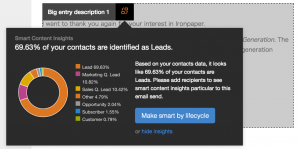
By its nature, B2B inbound marketing is innovative — that's why it works! But even within an inbound framework, marketers must stay up-to-date with technology to stay ahead.
Here are three innovative, technology-driven strategies to implement this year. By current trends, these tactics will become commonplace in the next few years, so stay up-to-date and stay ahead of competitors.
We're rapidly exiting the days when a one-size-fits-all website will do the trick.
Now, consumers are used to the idea that websites track their data. So they expect brands to personalize their online experiences — mainly based on relevant interests.
Just over half (58%) of web visitors want personalization based only on user information they proactively provide. Yet another group (38%) will specify their individual interests so that the site can personalize content. – CMO by Adobe
For example:
In one personalization example, Optimizely saw a 113% jump in visits to its solutions page and 117% increase in clicks on secondary CTAs by personalizing its homepage.
But how can you dish up a meaningful experience for every visitor? By using smart content.
 HubSpot's smart content allows you to personalize any rich text box on your website.
HubSpot's smart content allows you to personalize any rich text box on your website.
Smart content is a feature of marketing automation software (like HubSpot.) Basically, you can select different user groups (like first-time visitors, leads from a certain region, those with an interest in technology vs. fashion). Then, you write different content, which appears for each group.
Nearly three-fourths (74%) of online consumers get frustrated with websites when content (e.g., offers, ads, promotions) appears that has nothing to do with their interests. – HubSpot
This stat alone shows the urgent need for personalized content. By 2018, consumers will lose patience entirely for irrelevant web experiences — and bounce to your competitors instead.
B2B inbound marketing is very different from B2C in one main regard: Once you earn the initial conversion, your job isn't over yet.
Because in B2B, sales cycles are long (and still getting longer). In fact, sales cycles have grown by 22% on average, according to Kapost.
Therefore, buyers need to be more engaged through the buying journey than ever before — with more touches, more content, and more nurturing.
Yet, marketing automation can again help alleviate this pain point:
77% of businesses saw an increase in conversions when using marketing automation software. – VB Insight
This is largely because marketing automation makes conversion strategies more efficient and data-driven. And with automated workflows, no lead falls through the cracks.
In order to succeed with automated workflows, you'll need software that lets you create drip campaigns.
There are many versions of drip campaign software for all budgets. But we recommend a full-bodied tool like HubSpot, because it lets you "trigger" drip campaigns with cross-channel actions.
 HubSpot's workflows allow for gradual, triggered drip campaigns
HubSpot's workflows allow for gradual, triggered drip campaigns
For example, if a B2B lead visits a website page with pricing information, you could trigger a series of emails with product comparisons and pricing information.
And when you set up workflows for actions targeted through the funnel, you effectively move leads automatically through the buying cycle.
Traditional web design is on its way out. The legacy method often includes this redundant process:
But this method doesn't account for how well the website is actually performing.
Over 80% of marketers consider increasing overall conversion a dominant priority for their website optimization programs. – MarketingSherpa
Therefore, a growth-driven model will be important for B2B inbound marketing in 2018 and beyond.
 With growth driven design, you build by iterations, and inform decisions with data.
With growth driven design, you build by iterations, and inform decisions with data.
In a growth-driven model, you begin with marketing strategy — what are our business goals? How can we use our website for lead generation?
Then, you launch a launchpad website. Simply, this is a pared down website that lets you test out your message and gather data up front.
 Source: growthdrivendesign.com
Source: growthdrivendesign.com
After the launch phase, you analyze the results. Then, you would continually add to the website, and optimize what isn't performing well.
In other words, you're viewing your website redesign as an ongoing project — not a once-and-done item that gathers dust in between redesigns.
And with the vast availability of data today, there's no reason you shouldn't utilize it. Yet many marketers don't inform their website redesigns with data, analytics, or testing.
But the GDD model helps you in several ways:
So why wouldn't you choose it? Don't get stuck with an old website model that doesn't grow your business. Instead, invest in a GDD model that's equipped for the future.
Sources
CMO by Adobe https://www.cmo.com/features/articles/2015/2/18/mind-blowing-stats-personalization.html#gs.JBEx7yE
HubSpot https://blog.hubspot.com/marketing/data-personalize-marketing-li
VB Insight (2015) https://www.hatchbuck.com/blog/the-pulse-of-marketing-automation-platforms-in-2016/
Kapost https://kapost.com/content-marketing-facts/
MarketingSherpa via Shelley Media Arts https://blog.smamarketing.net/13-facts-that-prove-growth-driven-web-design-is-your-best-option
by Jonathan Franchell, CEO of Ironpaper - For more tips and hacks: Need to remove a new line after h1 tags? Both web designers and SEO practitioners need to employ headline tags: H1, H2, H3 in several ways to improve web page structure and tag...

The Crowded Arena of the IT Marketplace Updated December 2024 The Information Technology (IT) landscape is experiencing rapid growth and intensifying competition. IT spending is projected to reach nearly 5.1 trillion U.S. dollars in 2024, a...

Updated December, 2024 The field of digital marketing is evolving rapidly in response to new technology and changing buyer expectations. To help career-minded marketers, we’ve rounded up the top 10 skills needed to succeed in the field. These are...
